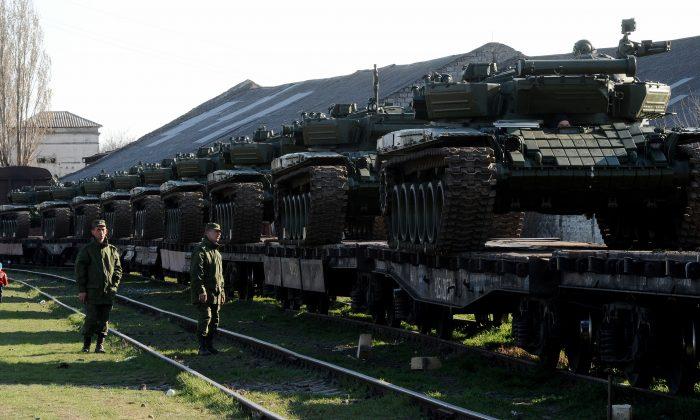Bloodshed in Europe and the Middle East against the backdrop of a breakdown in the dialogue between major powers is of enormous concern. The world is on the brink of a new Cold War, some are even saying that it has already begun. – Mikhail Gorbachev
Gorbachev may be right, but the “new Cold War” is very different to the old one. At the end of the Second World War in 1945, many within the Soviet and American governments had a genuine sense that their wartime alliance should continue. They hoped it would form the cornerstone of a peaceful and prosperous post-war world order divided into their respective spheres of influence.
The bankrupt Brits, in the throes of losing their empire, were less enthusiastic. So too were the Soviet and American hardliners whispering in the ears of Stalin and Truman.
By 1947, the goodwill had vanished. The hardliners were screaming as serious conflicts over Germany, Poland and Iran developed. By 1948, the Soviets and the West were in a standoff over Berlin. By the end of the decade, the Cold War had come to Asia, especially Korea, under the threat of mutually assured destruction by nuclear weapons.
Testing the Limits of Spheres of Influence
The question of what went wrong after 1945 to spark the Cold War has long occupied and divided historians. One key problem was that none of the major powers shared the same understanding of where their spheres of influence began and ended.
For all of their protestations, the British and Americans had to accept that Poland fell within the Soviet sphere of influence in Eastern Europe. Yet they drew the line at Stalin’s armed support for communist rebels in oil-rich Iran at the beginning of 1946. This was Britain’s backyard; Stalin had no place in it.
Though Stalin was testing the boundaries of his sphere of influence and quickly withdrew his troops from Iran, the hardliners interpreted the Soviet Union’s behaviour in Iran as part of a growing communist expansionism. They interpreted pretty much everything else the Soviets did thereafter in the same way. This misinterpretation elicited a similar one from Moscow and Cold War was now well under way.
Misinterpretations still abound in relations between Russia and the west, but today these are less about where one’s sphere of influence begins or ends. The European Union (EU) clearly no longer considers that Russia or anyone else has a legitimate sphere of influence at all in which they can operate to maintain their strategic interests.
Today’s Flashpoint: Ukraine
Many in the EU have stopped thinking in these or even geopolitical terms. Theirs is a post-nation-state universe of co-operation among partners for which military conflict is unimaginable.
After years of division and economic disaster, the pro-EU protests in Kiev a year ago reinvigorated this vision among EU idealists and expansionists in Brussels. For them, Ukraine is part of their united Europe and the next logical next step in the European project.
This logic is central to understanding why the EU worked so hard to help oust Viktor Yanukovych and “facilitate” a transition “government” that would accept their fantastic promises of huge money and even long-term integration. Neither promise looks likely to be met.
It explains why so many EU leaders failed to anticipate Russian president Vladimir Putin’s response to this “revolution”, which overthrew his ally Yanukovych and replaced him with a loose and unstable coalition of largely anti-Russian politicians.
The broader problem is that outside EU elites within Europe, not many other people live in the EU universe. Russia and Ukraine certainly don’t live there. This is slowly becoming apparent to many in the EU as frustration grows in Brussels with delays in improving endemic corruption in Ukraine and the financial burden it poses.
At the same time, Russia’s involvement in the conflict in eastern Ukraine continues. The exact nature and degree of this involvement is still unclear, as is the matrix of agents involved in this civil war.
Beyond a ramshackle Ukrainian national army and disparate rebel forces under competing commands, there are also mercenary armies under the control of local oligarchs and volunteers from both Russia and Ukraine. Some seem to be operating beyond organised military command structures. Russian special forces may also be involved. Civilians are stuck somewhere in the middle and suffering from all sides.
Seeing Putin as Stalin Reborn
The US tactic of putting pressure on Putin to do this or that in Ukraine and punishing Russia with sanctions when he fails to respond has never recognised this chaotic reality. This is despite many impartial observers on the ground reporting this fact. The Obama administration seems to see Putin as the puppet master in the same way as their predecessors saw Stalin.
The US response is not to recognise Russia’s sphere of influence beyond its own borders (not including Crimea), thus not recognising one at all. This is an extreme form of neo-containment policy unimaginable even to Cold War warriors. And it is being pursued (poorly) by an administration that is increasingly seen as incompetent in managing foreign affairs.
If not incompetent, then the Obama administration is at least unwilling to understand how American foreign policy in its self-designated “sphere of influence” in the Middle East over the past decade has taught others how big powers are supposed to behave. Putin is an avid observer.
The “new” Cold War is not as serious a threat to global security and even humanity as the old one. Some of the players aren’t even fighting over the same things now as they were in the “old” war. But misinterpretations still abound and these were and remain at the root of both wars. Where they will grow remains to be seen.
Filip Slaveski does not work for, consult to, own shares in or receive funding from any company or organisation that would benefit from this article, and has no relevant affiliations. This article was originally published on The Conversation. Read the original article.

Friends Read Free